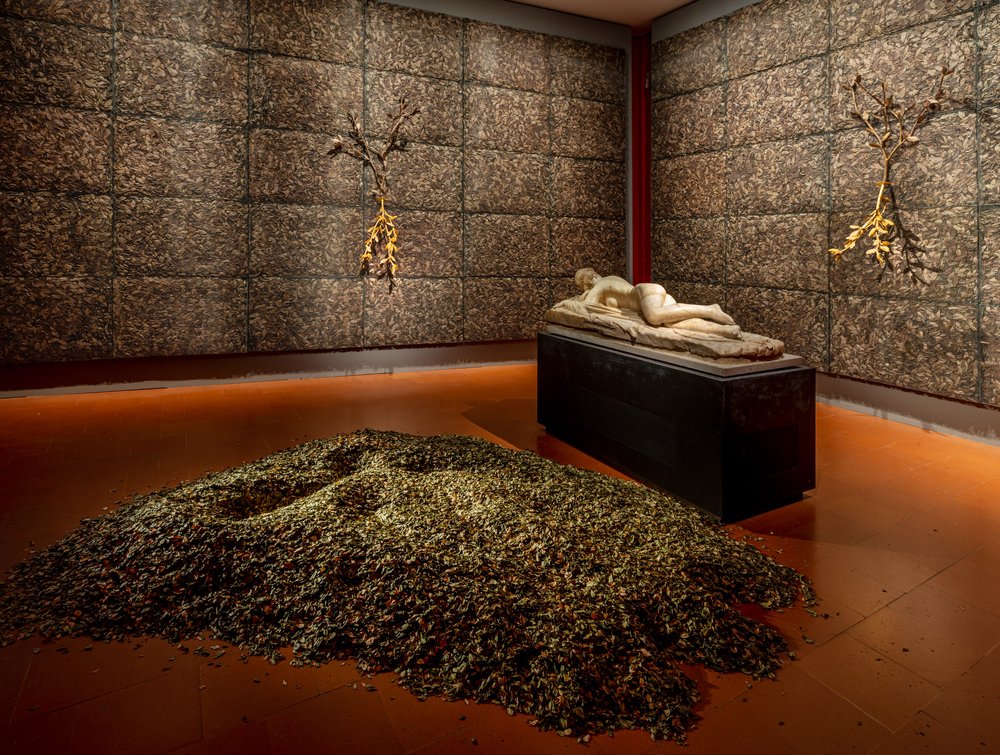‘Alberi in versi’ is inspired by the plant symbolism of a famous verse from Paradise in the Divine Comedy.
L”albero che vive della cima” (Divina Commedia, Paradiso, 18: 28-30) è la metafora guida di Alberi in versi, mostra dell’artista Giuseppe Penone nella Galleria degli Uffizi di Firenze dal 6 luglio al 3 ottobre. Si tratta di oltre trenta opere, tra sculture, installazioni, disegni e incisioni, disseminate lungo il percorso della Galleria. Oltre a costituire un omaggio al Sommo Poeta nei settecento anni dalla morte, esse ripercorrono anche i temi centrali dell’opera dell’artista.
An essential and necessary form, the tree has always been, for Penone, both an archetype of sculpture and living matter, akin to that of the human body. At the same time, the artist has chosen plants as a common denominator in his exploration of the ambivalent relationship between interior and exterior, positive and negative, human and vegetal, art and nature. The principle of “inverse” is also closely tied to the techniques used by the artist—casting and imprinting: these processes involve contact, through which different bodies and materials exchange form and substance, in a continuity without hierarchies between the human and the non-human.
The exhibition itinerary, chosen by the artist himself, begins with works from the late 1960s.
In It Will Continue to Grow Except at That Point (1968–1978), the theme of the relationship between humans and nature and the concept of time is already present, expressed in the sculpture through figurative devices. A paradigmatic example of the inverse— the mirror— is at the center of Turning One’s Eyes Inside Out (1970), where the visible stops at the threshold of the artist’s gaze, reflected on his eyes, which are temporarily blinded by mirrored lenses.
Penone gives drawing the language of sculpture: its constituent elements are, in fact, pressure, matter, and transformation, as seen in the 15-meter frottage People and Years (2020), exhibited here for the first time. The ‘writing of the forest’—that is, the imprint of a large tree created by rubbing leaves onto a linen canvas laid against the trunk—is echoed by a text written by the artist himself, almost like a long poem “in verse.”
The skin is also the ultimate organ of contact; it is the surface where the most democratic of images are generated in the form of imprints—images that everyone produces, which connect humans back to matter and nature. These are transformed into sensory maps whose nerve points turn outward toward the viewer in the large Acacia Thorns (2006–2014).
Once again, the theme of the epidermis offers the opportunity to place Penone’s work in dialogue with two ancient Roman statues located at the beginning of the west corridor of the Uffizi, each depicting the flayed Marsyas: deprived of skin, the body loses all boundaries, while the emptied skin becomes a virtual space. Near them, the artist chose to place Thoughts of Leaves (2014), where—hinting at the resemblance between human beings and the plant world—an anthropomorphic figure is covered by a garment of leaves that envelops it like a cloak. A mythological garment also dresses the large bronze sculpture titled Artemide (2019): a double cast of a tree showing both the inside and the outside, the hollow and the solid, with protrusions resembling breasts, like those of the Artemis of Ephesus, to which the title indeed refers. With the installation Breathing the Shadow (2000), Penone explores the space that breath fills and shapes within our body and that is in constant exchange with the external environment. The complementary relationship between plant photosynthesis and human respiration is recalled by the golden bronze lung made of leaves, placed between the cages that cover the walls, at the height of a human lung. Another poetic metaphor is found in Breath of Leaves (1979), where the negative imprint of the body and the trace left by the artist’s breath on a pile of boxwood leaves is echoed, at the center of the room, by the positive form of the Hermaphrodite’s body lying supine on a cushion—a symbol of the coexistence of opposites.
The exhibition also reaches out to the city and beyond the museum, into Piazza Signoria, with Abete, a monumental installation in steel and bronze over 22 meters tall, inaugurated as a preview of the exhibition on March 25, on the occasion of Dantedì.

